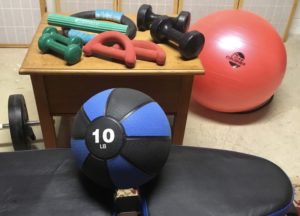Prepping for the new season
February 14, 2020

It’s exercise time for the new golf season
The Cape Region golf season officially begins April 1, when the Delaware State Golf Association’s handicap system starts accepting scores from local courses.
Well before then, however, golfers should be busy with their exercise or workout routines in preparation for better weather and pleasant playing conditions.
I met recently with Chris Krueger, Director of Instruction for Kings Creek Country Club and a Titleist Performance Institute certified golf coach. He provided a few tips for golfers readying themselves for the pleasant task of making full swings.
Krueger stressed that before doing any serious exercise golfers should consult their physicians to learn about any limitations they should respect.
“I recommend starting with the Child’s Pose, from yoga. It will help promote shoulder and ankle strength, and gives you a better chance to keep your swing in sequence,” Krueger said.
For this routine, kneel on the floor with your toes pointed away. Fold over your knees, with your buttocks touching above the heels. Resting your forehead on the floor or a mat, stretch your hands along the floor as far from your head as you can.
Several variations of this pose can be found online.
“Planks are probably the best” for most golfers, Krueger said. Resting on your elbows and toes, bring your back up and level, and maintain that position for an ever-increasing interval. “That’s probably the quickest way to develop core strength,” he said, recommending a set of 3 planks for 20 seconds each, up to a minute.
He also said many people benefit from a pelvic disassociation exercise, where the upper body remains still while the hips are turned as far as possible. “Doing this helps your body come into the slot better,” Krueger said. “It’s good for understanding the swing sequence better, and for your timing.”
We discussed using medicine balls for several useful exercises. In addition to simple twists while holding the ball, fit golfers can try a vertical squat/jump.
You will notice that with the exception of the medicine ball, no weight lifting is part of Krueger’s suggested routine. After all, very few recreational golfers need to look like Brooks Koepka or hit the weights like he does. However, light workouts with low weight barbells, such as forearm lifts and wrist curls, can improve muscle tone.
For those who don’t regularly walk five or six miles, those first few 18-hole rounds in the spring can be remarkably tiring. Cardio routines such as exercise bikes or rowing are a good way to develop stamina. Try thirty minutes or so on the bike several times a week, at a gentle pace to start.
The Distance Report
I read the 102-page Distance Insights Report published Feb. 4 by the United States Golf Association and the Royal & Ancient, along with a 15-page conclusions paper with additional perspectives, to save you the trouble of reading it yourselves.
You are welcome.
As many stories about the Report already noted, it contains no final recommendations to address the perceived problem with the “consistent increase in hitting distance and golf course lengths.” Further analysis will be scheduled.
It could lead to possible changes in equipment standards, or use of reduced-distance equipment in competition by use of a Local Rule, changes in equipment testing protocols, or alterations in course setups for high-level competitive events.
From my reading of the Report, however, I think the truly remarkable thing about golf since the introduction of the solid core golf ball (think Pro V1 in 2000), is how little has changed for over 99% of the golfing community in the last two decades.
For example, driving distance by handicap category has not significantly increased. Reports by Trackman and Arccos show current average male driver distances are about 214-217 yards. Changes in iron club lofts and shaft lengths produced slight increases, but only by a few yards.
What has occurred since 2000 is increased athleticism among professionals, collegiate players, and avid amateurs. Improvements in understanding biomechanics enhanced playing skills. Better instructional technique, the increasing use of custom club fitting, and a deeper understanding of course management have also played a role.
At the elite level these factors have certainly increased driver distances, but in my opinion most amateur golfers have not fully embraced these paths to improvement.
Furthermore, the solution to perceived excess distance in elite competition can be addressed by course set up without damaging the layouts. The 2013 U.S. Open took place on the relatively short 6,900 yard Merion East course, with Justin Rose winning at one over par. They did not add 1,000 yards to that course and it wasn’t necessary.
In my opinion, the real distance issue in golf is that too many amateur golfers still don’t play the proper set of tees for their actual driving skills and distances. Many more golfers should move up a tee box or two and give themselves as many chances to use an iron for their approach as their favorite pros on the PGA and LPGA Tours.
Wouldn’t that be fun?

